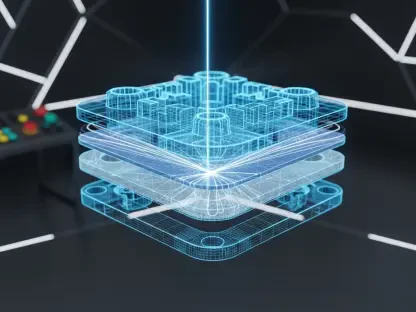In an era where digitization relentlessly advances across various industries, securing operational technology, especially within industrial control systems, becomes increasingly imperative. These systems, integral to sectors like manufacturing, power generation, and water treatment, face ever-evolving threats from cybercriminals intent on exploiting their vulnerabilities. The rise of sophisticated adversaries and more complex threat landscapes enhances the integration of artificial intelligence (AI) into these systems, offering promising pathways to bolster security. However, the deployment of AI in these environments presents unique challenges, from data quality issues to the intricacies of integrating AI with existing legacy infrastructure.
The Complexity of Industrial Network Defenses
Vulnerabilities in Industrial Systems
Industrial control systems were predominantly designed with a focus on performance and availability, sidelining robust security measures—an oversight that now poses profound vulnerabilities. Many of these legacy systems operate on outdated protocols like Modbus and DNP3, which inherently lack encryption or authentication features, making them susceptible to cyberattacks. Criminals exploit these vulnerabilities, especially as many systems are interconnected, magnifying the ramifications of a single breach. Given the critical nature of the functions controlled by these systems, from regulating power grids to managing water supplies, their security—or lack thereof—can have sweeping impacts on entire communities.
The legacy nature of equipment in these environments further complicates the cybersecurity landscape. These devices are often not designed to be updated or patched, which is necessary for mitigating emerging threats. As a result, they are more prone to exploitation by cyberattackers. Coupled with the interconnectedness of these systems, a breach in an isolated device can compromise broader operational processes, potentially causing catastrophic incidents. Recognizing these vulnerabilities, organizations increasingly look toward AI to strengthen their defenses, leveraging its capabilities to analyze and identify threats that might otherwise go unnoticed.
Integrating AI as a Cybersecurity Tool
Given the mounting threats to industrial networks, AI is emerging as a game-changer in cybersecurity, offering the ability to rapidly process substantial datasets and identify potential anomalies indicative of an attack. Its introduction into operational technology security strategies facilitates real-time threat detection, allowing systems to respond swiftly to threats and mitigate damage before it escalates. AI can enhance forensic capabilities, enabling security professionals to analyze intrusion patterns, discern malicious activities, and traverse through massive logs to piece together threat narratives.
Integrating AI into industrial environments, however, is not without challenges. The integration often necessitates significant alterations to existing infrastructure to support new technologies, considering the complexity and variety of equipment in these environments. Organizations may grapple with a shortage of skilled personnel who understand both AI and its application within industrial contexts. Despite these barriers, the promise of AI in augmenting cybersecurity defenses continues to drive its adoption. As familiarity and expertise with AI grow, industries stand to benefit from its potential to offer consistent and dynamic defense.
Expanding Threat Landscape and AI’s Evolution
The Rise of Cyber Threats Targeting Critical Infrastructure
In recent years, there has been a discernible increase in cyber threat activity targeting critical infrastructure, largely attributed to the convergence of IT and OT networks, which has inadvertently expanded the attack surface. Nation-state actors and well-coordinated cybercriminal organizations now exploit these interconnected networks, seeking to disrupt vital services for strategic or political gain. This convergence not only enhances operational efficiency but also complicates the security framework, giving adversaries additional entry points and escalating the stakes of maintaining a secure environment.
The sophistication of these threats necessitates a transformation from traditional defense mechanisms to more proactive and dynamic cybersecurity strategies—an area where AI can significantly contribute. Artificial intelligence, with its advanced machine learning algorithms, provides predictive insights, thus enabling preemptive defense strategies. By evaluating patterns within vast datasets, AI can identify emergent threats before they cause damage, offering organizations a valuable edge in safeguarding their operations. As adversaries continually adapt their tactics, these AI-driven systems are equally capable of evolving, ensuring that defenses remain one step ahead.
Harnessing AI for Advanced Threat Detection
AI’s ability to deliver unparalleled insights into potential security breaches aligns with the demands of monitoring expansive and complex networks characterizing industrial systems. By implementing predictive security analytics, organizations can proactively assess where vulnerabilities exist and what potential breaches might occur. AI’s capabilities extend to flagging abnormal network behavior, both minimizing false alarms and ensuring operational efficiency remains uncompromised. Real-time analysis inherent in AI systems aids in rapidly distinguishing genuine threats from routine activities, enabling a swift and informed response.
The potential for AI to advance asset management is another noteworthy aspect. Through AI mechanisms, organizations can engage in automated asset discovery, effectively cataloging devices and providing a comprehensive overview of what requires protection. Maintaining accurate records through such automated processes is pivotal for compliance reporting and strategic security planning. As these systems continue to evolve, the balance between AI’s predictive capabilities and human expertise becomes crucial, ensuring that technological solutions are effectively applied to address human-centered security challenges.
Opportunities and Challenges in AI Adoption
Benefits of Predictive Security and Enhanced Asset Management
The implementation of AI in industrial control systems introduces transformative opportunities for enhanced security management. AI’s capability in predictive analytics significantly improves decision-making by anticipating equipment failures and identifying maintenance requirements, thus enhancing system reliability and security. This foresight is especially critical in industries where equipment downtime translates to significant financial losses and operational disruptions. By optimizing performance and providing security insights, AI-equipped systems ensure that potential vulnerabilities are addressed before they result in tangible threats.
AI’s role extends into asset management, providing organizations with tools to automatically discover and catalog system components, thereby ensuring thorough audits of existing security measures. Comprehensive oversight facilitates compliance with established security standards and can streamline the process of documentation required by frameworks such as IEC 62443 and NIST. As these regulatory requirements evolve, AI proves invaluable in maintaining operational compliance, offering organizations assurance that they adhere to requisite guidelines, minimizing the risk of security breaches and associated legal repercussions.
Addressing Implementation Challenges in Industrial Environments
While AI presents numerous advantages in enhancing the cybersecurity posture of industrial systems, its deployment poses significant challenges. The integration of AI requires high-quality data sets, yet many industrial environments exhibit fragmented data systems, hindering seamless AI application. The proprietary format often found in legacy systems can obstruct data integration efforts, impacting AI’s efficacy in detecting and mitigating threats. Organizations must prioritize efforts to overcome these data-related obstacles to fully leverage AI’s capabilities.
The incidence of false positives generated by AI systems presents another challenge for cybersecurity teams. These misidentifications can result in alert fatigue, where security personnel become overwhelmed by alerts, potentially overlooking genuine threats amidst a sea of noise. Balancing AI systems to minimize false positives without reducing threat detection efficacy requires a fine-tuned approach, significant expertise, and consistent monitoring. Organizations must invest in training their teams to navigate AI’s nuanced functionalities, blending machine capabilities with human insight to achieve optimal security outcomes.
Strategic AI Integration in Industrial Cybersecurity
Phased Approaches and the Hybrid Model
Implementing AI strategies within operational technology settings is an endeavor best approached gradually, ensuring disruptions are minimized and strategies are optimally aligned with organizational goals. Phased deployment, starting in non-critical systems, allows organizations to test AI’s effectiveness, build necessary expertise, and refine systems before expanding to critical areas. This incremental strategy enables businesses to address technical challenges sequentially, minimizing potential risks and ensuring uninterrupted operations as AI capabilities are progressively incorporated.
The synergies between AI technologies and human expertise produce a formidable defense against cyber threats. While AI excels in managing routine, data-intensive tasks, cybersecurity professionals provide the discernment and strategic leadership necessary to address complexities unresolvable through automated systems alone. By harmonizing AI acumen with human insights, organizations can leverage the strengths of both, maximizing resource efficiency and enhancing overall security effectiveness. This partnership empowers businesses to continually adapt to emerging threats while maintaining their operational integrity.
Building Internal Capabilities and Overcoming Skill Gaps
In the current age, where digitization is progressing rapidly across different industries, safeguarding operational technology, especially within industrial control systems, is becoming increasingly critical. These systems are fundamental to the functions of major sectors such as manufacturing, power production, and water treatment. The ongoing threat posed by cybercriminals determined to exploit any vulnerabilities remains a major concern. These attackers are becoming more sophisticated, leading to complex threat landscapes that demand attention. The advent of artificial intelligence (AI) presents a promising solution for enhancing security in these systems. AI can revolutionize how security measures are implemented, offering advanced protective mechanisms and predictive capabilities. Yet, incorporating AI into industrial environments isn’t straightforward; it comes with distinct challenges. Issues such as data quality can hinder AI’s effectiveness, while the complexity of merging AI with existing legacy systems adds another layer of difficulty. It’s crucial to navigate these hurdles carefully to harness AI’s full potential in strengthening operational security and ensuring the resilience of critical infrastructures.









